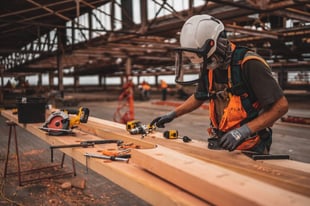Construction’s Age Problem: A Foreboding Exodus of Experience
Construction’s workforce isn’t getting any younger.
In 2022, the median age of construction and extraction occupations workers was 41.2, and about 45% of construction workers were 45 and older, according to the most recent Bureau of Labor Statistics data available.
That’s due in part to the aging of the overall population – the nationwide median worker age in 2022 was 42.3 – but construction has felt that increase more than other industries, according to BLS.
The causes for the workforce’s age increase are many and so are the trend’s potential detrimental impacts.

“As many members of the senior workforce retire from construction, there aren’t enough qualified, experienced folks to take their place,” said Marianne Monte, chief people and administration officer for Boston-based Shawmut Design and Construction. “There are many factors that contribute to this talent shortage, starting with the Great Recession when the demanding, uncertain nature of construction led people to switch industries.”
A smaller talent pool has forced some contractors to turn down work on new projects, said Kris Manning, chief operating officer of Bethesda, Maryland-based Clark Construction. While there is a high demand for construction projects, many contractors simply don’t have the staff.
That can even become a self-fulfilling prophecy. Keyan Zandy, CEO of Skiles Group, a Richardson, Texas-based contractor primarily specializing in healthcare projects, noted that seasonal work, long hours and a perceived lack of stability have made it challenging to retain and attract younger workers.
“During economic downturns, construction projects often decline, leading to layoffs and a decrease in new job opportunities,” Zandy said. “This can discourage younger individuals from entering the industry or pursuing construction-related education and training.”
Experts told Construction Dive that more focus on recruiting and retention efforts, technology improvement and continued investments in education will help ensure that the industry can bounce back when more experienced workers retire.
The Big Picture
One way to bring more fresh faces into construction is to invest in getting in front of students at younger ages.
Manning said big-scale solutions include introducing skilled trades to students in elementary and middle school, while also developing and investing in trade schools and community colleges to attract more high school students not interested in college, or adults looking for a career change.
“These schools understand the needs of local employers and can provide tremendous value for dollar spent per credit,” Manning said.
A Push for Inclusion
In the process of upping recruiting, Monte said the industry needs to do more to enhance diversity and inclusion initiatives.
“The stereotype that construction is a predominantly older white, male industry exists for a reason, and has created a very narrow view of the opportunities that are available – and who they’re available to,” Monte said.
In recent years, Monte said, the industry has made progress recruiting women and minorities, in part due to an increased focus on STEM students and investments in apprenticeship programs for developing careers of skilled tradesworkers.Once recruited, that young, diverse workforce needs to have both a sense of belonging and get benefits they feel reward their hard work, Zandy said.
“We must acknowledge and address concerns about long working hours and limited work-life balance by implementing flexible schedules, promoting work-life integration and providing benefits supporting employees' well-being,” Zandy said, adding that his company’s unlimited vacation policy has helped with burnout.
Now is the time to invest in benefits that continue to recruit underrepresented groups, experts say. Providing childcare support is one example of how an employer can help clear a major hurdle to women looking to build a career.
In the meantime, empowering workers to speak up about workplace conditions is vital. Often, women or other underrepresented groups will simply leave, rather than address the issue. Making DEI initiatives a full commitment, more than a binder on a shelf, can be instrumental in helping workers feel welcome in their careers.
Tech's Role
At one point in his career, Richard Humphrey, vice president of construction for software firm Bentley Systems, said he was fed up with construction’s resistance to adopting new technology. Though that sentiment remains for some contractors, in his current role he works to show contractors how tech can make their jobs easier, using digital twins and building management to help contractors plan and execute projects.
Humphrey said that with the wave of retired workers, there can be a brain drain, where they take experiential knowledge with them. By the same token, workers earlier in their career more often accept changes in procedure.
Digital twins and planning are great examples of overhauling the project lifecycle, and are increasingly accepted in the industry. Humphrey pointed to the many infrastructure projects coming down the pike, indicating that, should a few state DOTs adopt more digital twin and app-based management platforms, others would fall in line.
Additionally, proponents of artificial intelligence say the technology can help with productivity without directly replacing people. Completing tasks like estimating takeoffs or identifying workplace hazards won’t exactly take jobs, as some fear, but rather help experienced decision makers or skilled tradesworkers know what to expect and perform their jobs better.
That can increase productivity, and help attract and retain a younger workforce of “gamers.”
No matter what, Humphrey said, there must be change.
“The only way to shrink that gap is to stop doing things the way they are,” Humphrey said.
This article was written by Zachary Phillips from Construction Dive and was legally licensed through the Industry Dive Content Marketplace. Please direct all licensing questions to legal@industrydive.com.

-1.png?width=112&height=112&name=image%20(4)-1.png)













